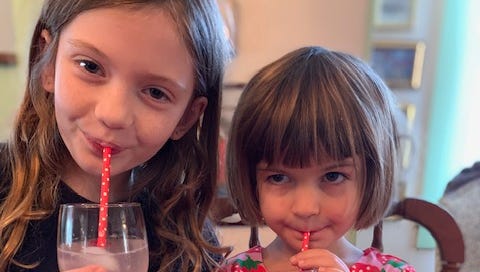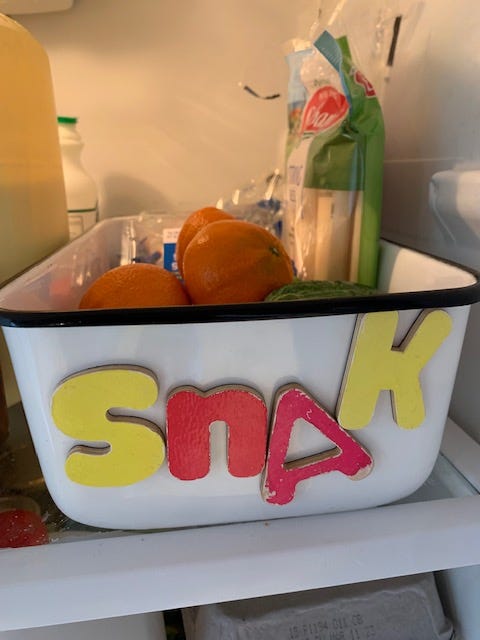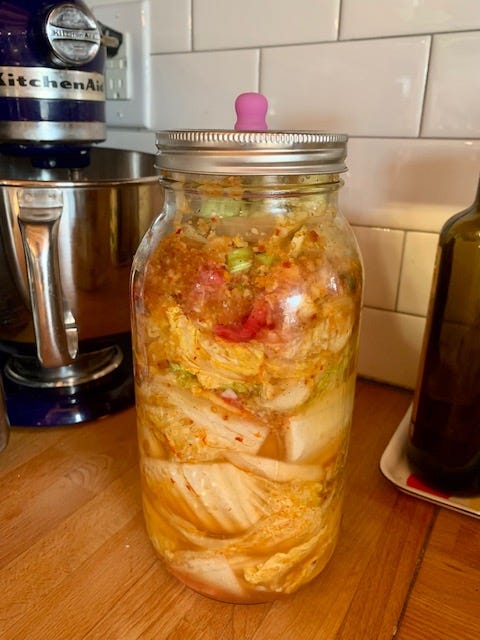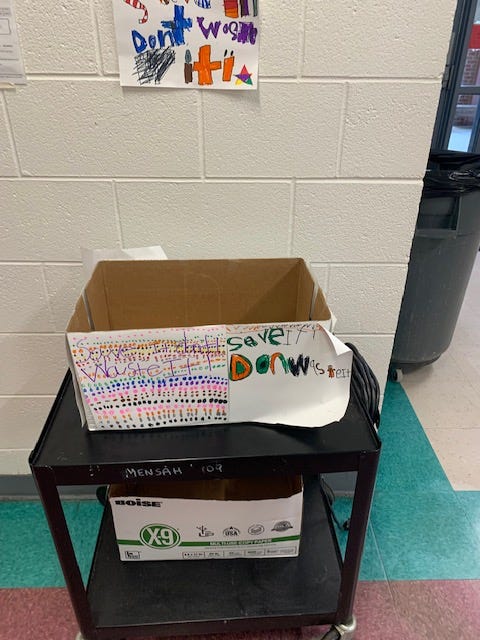My friend Catey is a great cook, writer, mom, and all-around-creative person. She’s also the type of person—she’ll tell you this herself—whose creativity benefits from constraint and limitation. She’d totally win one of those reality cooking shows where they give you a set number of random ingredients and you have to put together a meal. In fact, she often does this, forcing herself to use up what’s left in the pantry and fridge before heading to the market. She makes a lot of frittatas, stews, and casseroles—and rarely from a recipe. She doesn’t need one, because she can put together what she has with what she knows her family likes, just by scanning ingredients.
I’m the opposite. I cook mainly from recipes and am a collector of cookbooks, especially vegetarian and family-oriented cookbooks. I love reading about food and frequently change my mind about what I’d like to try making next. New recipes and food stories are what spark my creativity, especially during the winter months when I crave variety and rarely go out to eat.
Cooking is fun for me—and we’ve kept up our weekday vegetarianism, I’m happy to say—but my attraction to novelty means extra trips to the store, overbuying, and ultimately, food waste. American food waste contributes more to greenhouse gas emissions than commercial aviation, and households are responsible for nearly forty percent of our food waste.
Composting scraps at home and using all of what you buy is one way individuals can make a difference. In fact, according to Project Drawdown, reducing food waste can make an even bigger difference than converting people to a plant-rich diet:
When food is wasted, all the energy, resources, and money that went into producing, processing, packaging, and transporting it are wasted, too. Producing uneaten food squanders a whole host of resources—seeds, water, energy, land, fertilizer, hours of labor, financial capital—and generates greenhouse gases at every stage. The food we waste is responsible for roughly 8 percent of global emissions.
So it’s my goal to be more like Catey, more like those of you who lean into leftovers, who invent new frittatas and casseroles and fried-rice meals that use up all your scraps. This will obviously save money and time, but it’ll also help us lighten our carbon footprint in a meaningful way.
So here are a few steps I’ve taken…
I cleaned out my fridge at the start of the year. I mean I completely cleaned it out, removing all the jars of pickles, mustards, mystery foods, etc., and washing the shelves, drawers, and sides before consolidating and returning what was still fresh. This was a task, but it felt good to start with a blank slate, especially as I am not a naturally organized fridge keeper and I love ingredients (like capers, pickles, spice pastes, and veggies) that can get lost in the fridge hinterlands.
In Super Natural Simple, Heidi Swanson writes about “merchandising” what you have. She says it helps her get excited about cooking and makes it easier to use her existing ingredients:
Evert weekend I spend ten minutes or so organizing the fridge. I compost anything that’s past its prime, I pull ingredients to the front of the refrigerator if they need to be used ASAP, and I review whatever is hiding in the drawers. If I have a few extra minutes, I like to wash, chop, and otherwise prep some vegetables, then place them in clear jars at the front and center. This allows me to see my cooking palette with a glance and helps me feel bright, excited, and optimistic about our next meal. This little practice also makes a big impact, dramatically reducing food waste.
Aside from Mason jars, my favorite merchandising tools are vintage enamelware fridge bins. They’re pretty easy to find at thrift stores or on Etsy, and have metal lids that make them useful for taking on picnics. I keep one open in our fridge and load it with kid snacks.
My friends Cat and David gave me a jar of delicious preserved lemons in December, and I’ve been using them in everything, especially rice bowls and sandwiches. I think having more exciting condiments can help you be creative, and the most exciting condiment/food I know is kimchi. So yesterday I made a big jar of it, and Bea and I are really excited to try it when it’s ready in a few days. I used this recipe from the New York Times, which was my gateway to subscribing to the food section. (I really wish the Times, like Epicurious, would stop publishing new beef recipes.) If you don’t have a subscription, you can still click on my link—it’s a gift link, and even though I haven’t tried this batch yet, I’ve made the recipe before and loved it. You can get gochugaru at Asian markets or Trader Joe’s. If you want the recipe to be vegetarian, combine miso paste and soy sauce to sub for the fish sauce.
Kimchi is a great example of a traditional dish designed to use what you have and to get people through a long winter. It’s delicious as a bright, briny side dish or in Korean recipes like bibimbap. I also like it in easy-to-make standbys like grilled cheese and quesadillas. Just make sure that you use a fermenting lid (like the one below), or use a loosely-screwed on plastic lid (like a saved mayo jar lid). Otherwise your jar might explode! And you might have to get divorced! (Richard is not a fan of pickled foods.)
So that’s what I’m doing so far. But the best way for my family to make changes is actually inventorying and challenging ourselves to use what we have. Yesterday at Walmart Bea and I saw a good deal on what was honestly the largest bag of small cucumbers I’ve ever seen. “That’s a big bag,” I said. “Are you sure we can eat that many?” “Oh yeah,” Bea told me. “I can always eat cucumbers.”
So the cucumbers will be a test. Can we eat them all? Tune in next time…
Also, Bea wants to tell you about a terrific first grade food-saving project at her school:
Save it, Don’t Waste It!
Last Monday, I brought my lunch. It was leftover spinach pasta,{ which all my friends were jealous of. But after eating, I was still a little hungry. So I went to the Save It! Don’t Waste It! bin in my school’s cafeteria and picked out a bag of chips.
This bin was an idea that came from Mrs. Hodge’s first grade class. They read a book called Maddi’s Fridge about a family who did not have enough food. The book inspired them to think about the food we sometimes waste at school. They decorated a cardboard box and called it the “Save It! Don’t Waste It!” bin , where anytime a student has too much food and can’t eat it all they can just drop it off. Then, if a kid doesn’t have enough, they can grab it. The bin is for unopened packaged foods like chips, juice boxes, applesauce, or even fruit.
I think the bin is a great idea because it helps us reduce food waste and help each other. Does your school have something like this? Maybe it should!








Personally, I think the best meals that I make are when I just use what I got at home and make it work. In a way, cooking like that is art. You have to be creative, trust the process, and sometimes you didn’t even anticipate the final product though it turns out exactly as it was meant to be. For me, cooking is a representation of culture, skill, and identity. I want my love for family, people, and the planet to be clear in the food I make.
I am going to clean out my fridge, freezer, and pantry next week. ( maybe one each week over 3 weeks). You have inspired me. I am going to check with my grandson, Miles, to see if his school has a Save It! Don't Waste It! box in their cafeteria., and suggest it, if they don't. I also am going to look into composting.
Belle and Bea, ask Mamie about the dog pan at your Boone cousins' house when she was growing up. It was totally disgusting but there was never any wasted food in our house. If I only had 4 big hunting dogs! I thought of it immediately when I saw the snack box in your fridge.
Thanks as always for the FTT. It is always such a wonderful source of information, and inspiration. My love to all.